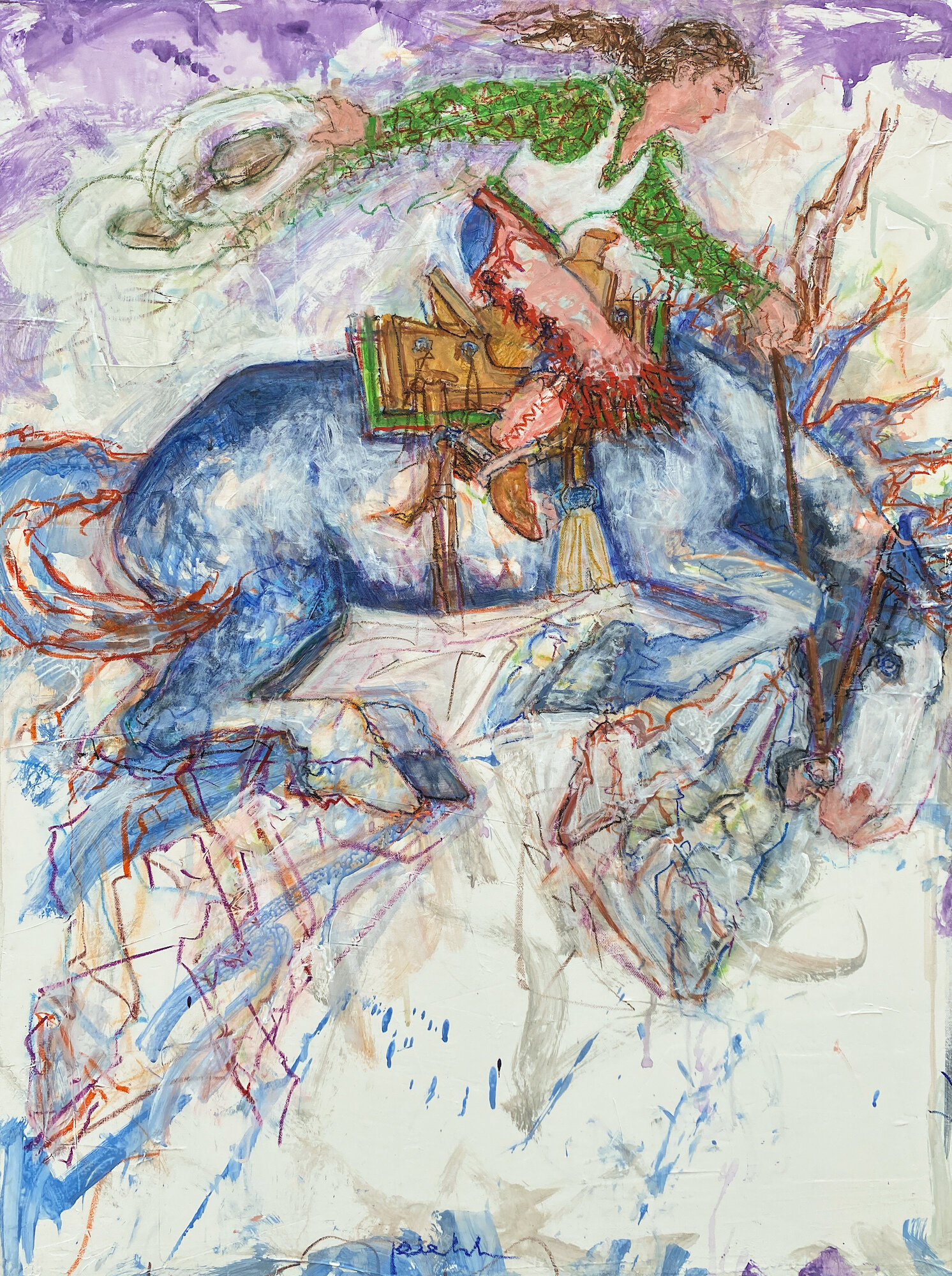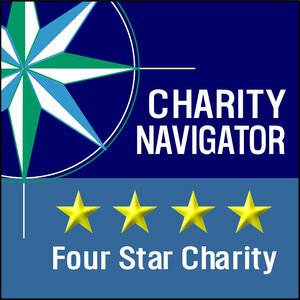Walter Piehl, Jr.’s painting, Betsy and Blue Buttes: Cowgirl Suite (2021), acrylic on canvas, installed in the Wiegand Gallery. Walter’s piece, graciously donated to our Permanent Collection, was hung in the gallery on Jan. 5, 2022, by Programs Manager Brad McMullen and Gift Shop Assistant Bob Aguirre. Look closely and you can also see Jo Mora’s “Sweetheart of the Rodeo” image in the background.
This month, we welcomed a new addition to the Wiegand Gallery—Walter Piehl, Jr.’s original painting of Betsy and Blue Buttes: Cowgirl Suite (2021). Betsy and Blue Buttes has become our guiding inspiration for the 2022 year of programming that we’re calling the Wild Ride. We’re lucky that Walter has given his blessing to use the image in our designs and donated the original piece to the Western Folklife Center’s permanent art collection. The silk wild rag and vintage-rodeo-poster-sized-poster for the year, featuring his artwork, are stunning. Betsy and Blue Buttes, emblematic of Walter’s style, bursts with color and movement… and it’s even more striking on canvas. It’s a testament to Walter’s artistic expertise, his stylistic process, and his lifelong commitment to new expressions in the “western Americana” genre that stem from a contemporary cowboy way of life.
The North Dakota Cowboy Hall of Fame quotes rodeo poet Paul Zarsyski,
"If you want health? If you want spiritual nourishment? If you want the fountain of youth? Hang a Walter Piehl on your wall and let it dazzle you daily!"
Walter describes growing up in Marion, North Dakota, as a “hardscrabble, rural, farm/ranch kind of situation, without [reliable electricity], no indoor plumbing”... an upbringing where “drawing was always a big part of my life.” His father, Walter Piehl, Sr., was a horse dealer, stock contractor, and part-time rodeo producer (he started Dakota Rodeo, Inc.). Walter (Jr.) found his place in the family business as a rodeo announcer, going on to announce for 30 years and later serving as president of the Roughrider Rodeo Association. His wife Becky who he “met at the pencil sharpener” in grade school, also worked in the family rodeo business. After moving to Minot, Walter worked at a livestock yard and moved cattle in the summer, a way of life he has passed on to his four children (you may know his son, Shadd) and five grandchildren.
While being involved with rodeo life, Walter was also becoming an art teacher, earning his BA in art from Concordia College and an MA and MFA from the University of North Dakota Grand Forks. Walter wanted to share his love of art in a place far from art museums. He also notes his “great fear of the haystack,” as motivation to pursue a career that did not involve pitching hay in 104 degree weather. He stayed out of the haystack as a professor of art at Minot State University from 1970 to 2018. Well known as a teacher and mentor, Walter was even a one-time owner of a bar called The Blue Rider–a community spot in an art-filled, salvaged, historic, woodframe, downtown Minot building.
From this convergence of art training and rodeo training, emerged Walter’s renowned and genre-busting work. Walter has always been a standout in a storied tradition. His participation at the first Cowboy Poetry Gathering illustrates his contribution to, and breakaway from, the cowboy art canon. As part of the 1985 Gathering, an exhibition of Cowboy Illustrations, curated by Hal Cannon, Meg Glaser, and others, opened at the Northeastern Nevada Museum. Walter’s work is pictured at the far left, a flash of movement among more static ‘snapshot’ storytelling.
Photo from the Western Folklife Center archives, courtesy of Hal Cannon.
As Walter found his artistic voice, he grappled with customary modes to illustrate the subjects he wanted to depict. He says, starting out, “I was so used to calendar art, to illustration, to cowboy art as it appeared in the magazines, I had a hard time.” Classic cowboy art is highly detailed, each picture conveying elements of story, perhaps most notable in the works of Charles M. Russell and Frederic Remington, or in illustrations popular during the 1950s and 1960s. These narrative illustrations visually depict intricate scenes and events in a highly realistic, representative, even photographic, style. And, they speak to a taste for sentiment and romance… a sensibility that Walter initially hesitated to bring into his work as a new student in an unfamiliar art world. But, when a teacher encouraged him to bring his rodeo life into his work, rather than continue painting “lame and insipid” landscapes, Walter defined the subject matter that grounded his life and would come to ground his art. Ultimately, he’d go from busting broncs to busting genres, bringing a new sensibility to the visual language of contemporary cowboy art, keeping the feeling, while increasing the sensory.
Walter’s catalog includes still lifes of boots, saddles, skulls, and other western Americana. But, he is renowned for his series and suites that burst with movement and reinterpret western romance and sentimentality. For example, in his “Sweetheart of the Rodeo” series, the “sweetheart” is the bronc. (And, yes, the name of the series is a reference to the Jo Mora image, and also to The Birds’ album cover… a delightful coincidence alongside our current Mora exhibition.) Walter doesn’t shy away from shared references with both rock and roll and country albums… it’s quite fitting that the first thing he does when he paints is tie a bandana around his head. Nor does he shy away from shared references with both abstract expressionists and cowboy illustrators.
Walter Piehl: Sweetheart of the Rodeo (from Prairie Public Television, 2011)
To embrace the rodeo and to capture the energy of roughstock action, Walter paints what he knows: “rodeo in the flow.” Rather than paint from photographs, he paints from the images in his head of real broncs and bucking bulls. His paintings may be abstract and expressionist, but his subjects are famed, named, individual broncs and bulls. His process involves drawing, overdrawing, re-drawing, and then applying paint with quick swipes, manipulating line, enhancing color, and creating rich, living surfaces. Walter says,
“I want people to know how fast a brush stroke was put on and that paint is a fluid medium, that it drips, and it splatters, and those drips and splatters are collateral enhancements... I want them to look like they were done in a frenzy of activity and that the paint was applied with great energy.”
It really is a rodeo in paint.
Listen to Walter explain it himself. In his 2017 TEDx talk, he humorously “proves his cowboy credibility” and talks about his influences. As he says,
Walter Piehl: Was Western Art Limited and in a Rut? (from TEDxBismarck, 2017)
“Art should be unlimited, art should be open to originality, uniqueness, and hopefully, to paraphrase a cliche that is so often used today, as artists, as musicians, as poets, as everyone, we should learn to think outside of the loop.”
One of the finest testaments to the expressive power of Walter’s thinking outside the loop might just be the bareback rider cowboy who, upon seeing Walter’s work, said it was the first painting he‘d seen that “felt like the ride.”
In the years since 1985, the Western Folklife Center has had the pleasure of working with Walter. At the 2006 Gathering, he taught the “Art in Motion: Drawing in the West” workshop and in the same year filled the walls of the Pioneer Saloon with his action-filled artwork. This led to a commission of a "running with the bulls" Elko Basque Festival poster. Walter donated the paintings not selected for that poster to the Western Folklife Center's collection and they are currently on display in our Fireplace Nook.
Betsy and Blue Buttes: Cowgirl Suite (2021), Walter Piehl
In pondering artists and artwork that would best evoke the (sadly cancelled) 2022 Gathering's "Keeping the West Wild" theme, it didn't take staff long to zero in on Walter’s work. Walter accepted our invitation and immediately went to work on a new piece to fit, providing us with a brand-new original. When we shifted gears to program an ongoing series in 2022, his Betsy and Blue Buttes continued to “feel like the ride” for us, and so was born the 2022 Wild Ride. We’re excited that this year’s unexpected twists and turns now means that Walter’s artwork will be guiding us all year long. And, we look forward to working more with Walter in the year ahead. Keep an eye out!







